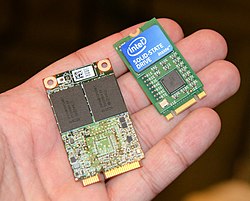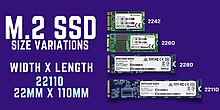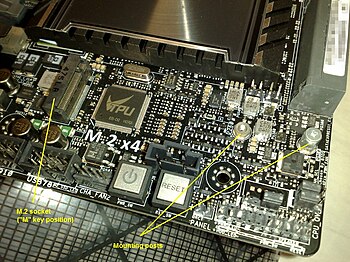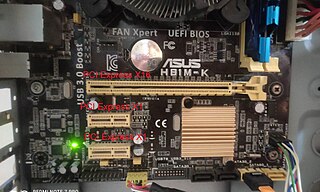
PCI Express, officially abbreviated as PCIe or PCI-e, is a high-speed serial computer expansion bus standard, designed to replace the older PCI, PCI-X and AGP bus standards. It is the common motherboard interface for personal computers' graphics cards, capture cards, sound cards, hard disk drive host adapters, SSDs, Wi-Fi, and Ethernet hardware connections. PCIe has numerous improvements over the older standards, including higher maximum system bus throughput, lower I/O pin count and smaller physical footprint, better performance scaling for bus devices, a more detailed error detection and reporting mechanism, and native hot-swap functionality. More recent revisions of the PCIe standard provide hardware support for I/O virtualization.

SATA is a computer bus interface that connects host bus adapters to mass storage devices such as hard disk drives, optical drives, and solid-state drives. Serial ATA succeeded the earlier Parallel ATA (PATA) standard to become the predominant interface for storage devices.

On older personal computer motherboards, the southbridge is one of the two chips in the core logic chipset, handling many of a computer's input/output functions. The other component of the chipset is the northbridge, which generally handles onboard control tasks.

ExpressCard, initially called NEWCARD, is an interface to connect peripheral devices to a computer, usually a laptop computer. The ExpressCard technical standard specifies the design of slots built into the computer and of expansion cards to insert in the slots. The cards contain electronic circuits and sometimes connectors for external devices. The ExpressCard standard replaces the PC Card standards.
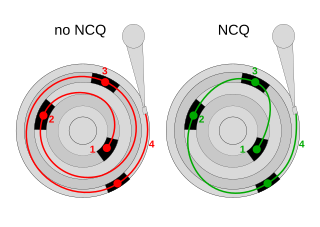
In computing, Native Command Queuing (NCQ) is an extension of the Serial ATA protocol allowing hard disk drives to internally optimize the order in which received read and write commands are executed. This can reduce the amount of unnecessary drive head movement, resulting in increased performance for workloads where multiple simultaneous read/write requests are outstanding, most often occurring in server-type applications.
The Advanced Host Controller Interface (AHCI) is a technical standard defined by Intel that specifies the register-level interface of Serial ATA (SATA) host controllers in a non-implementation-specific manner in its motherboard chipsets.

PC/104 is a family of embedded computer standards which define both form factors and computer buses by the PC/104 Consortium. Its name derives from the 104 pins on the interboard connector (ISA) in the original PC/104 specification and has been retained in subsequent revisions, despite changes to connectors. PC/104 is intended for specialized environments where a small, rugged computer system is required. The standard is modular, and allows consumers to stack together boards from a variety of COTS manufacturers to produce a customized embedded system.

A solid-state drive (SSD) is a type of solid-state storage device that uses integrated circuits to store data persistently. It is sometimes called semiconductor storage device, solid-state device, and solid-state disk.
I/O Controller Hub (ICH) is a family of Intel southbridge microchips used to manage data communications between a CPU and a motherboard, specifically Intel chipsets based on the Intel Hub Architecture. It is designed to be paired with a second support chip known as a northbridge. As with any other southbridge, the ICH is used to connect and control peripheral devices.

LGA 1155, also called Socket H2, is a zero insertion force flip-chip land grid array (LGA) CPU socket designed by Intel for their CPUs based on the Sandy Bridge and Ivy Bridge microarchitectures.
The Intel X79 is a Platform Controller Hub (PCH) designed and manufactured by Intel for their LGA 2011 and LGA 2011-1.
NVM Express (NVMe) or Non-Volatile Memory Host Controller Interface Specification (NVMHCIS) is an open, logical-device interface specification for accessing a computer's non-volatile storage media usually attached via the PCI Express bus. The initial NVM stands for non-volatile memory, which is often NAND flash memory that comes in several physical form factors, including solid-state drives (SSDs), PCIe add-in cards, and M.2 cards, the successor to mSATA cards. NVM Express, as a logical-device interface, has been designed to capitalize on the low latency and internal parallelism of solid-state storage devices.

SATA Express is a computer bus interface that supports both Serial ATA (SATA) and PCI Express (PCIe) storage devices, initially standardized in the SATA 3.2 specification. The SATA Express connector used on the host side is backward compatible with the standard SATA data connector, while it also provides two PCI Express lanes as a pure PCI Express connection to the storage device.
Solid-state storage (SSS) is non-volatile computer storage that has no moving parts; it uses only electronic circuits. This solid-state design dramatically differs from the commonly-used competing technology of electromechanical magnetic storage which uses moving media coated with magnetic material. Generally, SSS is much faster but more expensive for the same amount of storage.

U.2, using the port SFF-8639, is a computer interface standard for connecting solid-state drives (SSDs) to a computer. It covers the physical connector, electrical characteristics, and communication protocols.
Virtium Solid State Storage and Memory is a privately held American company that manufactures semiconductor memory and solid-state disk (SSD) products for data storage in industrial/machine-to-machine designs, embedded systems, including small-footprint designs, and Industrial Internet of Things (IIoT) applications. The company's primary markets of focus include defense, industrial systems, network communications, and transportation. The name Virtium is derived from the word virtue.

CFexpress is a standard for removable media cards proposed by the CompactFlash Association (CFA). The standard uses the NVM Express protocol over a PCIe 3.0 interface with 1 to 4 lanes where 1 GB/s data can be provided per lane. There are multiple form factors that feature different PCIe lane counts. One of the goals is to unify the ecosystem of removable storage by being compatible with standards already widely adopted, such as PCIe and NVMe. There already is a wide range of controllers, software and devices that use these standards, accelerating adoption.
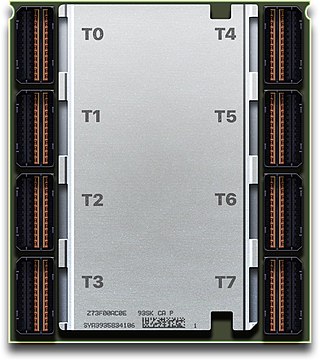
Power10 is a superscalar, multithreading, multi-core microprocessor family, based on the open source Power ISA, and announced in August 2020 at the Hot Chips conference; systems with Power10 CPUs. Generally available from September 2021 in the IBM Power10 Enterprise E1080 server.
The Enterprise and Data Center Standard Form Factor (EDSFF), previously known as the Enterprise and Data Center SSD Form Factor, is a family of solid-state drive (SSD) form factors for use in data center servers.
Compute Express Link (CXL) is an open standard interconnect for high-speed, high capacity central processing unit (CPU)-to-device and CPU-to-memory connections, designed for high performance data center computers. CXL is built on the serial PCI Express (PCIe) physical and electrical interface and includes PCIe-based block input/output protocol (CXL.io) and new cache-coherent protocols for accessing system memory (CXL.cache) and device memory (CXL.mem). The serial communication and pooling capabilities allows CXL memory to overcome performance and socket packaging limitations of common DIMM memory when implementing high storage capacities.

